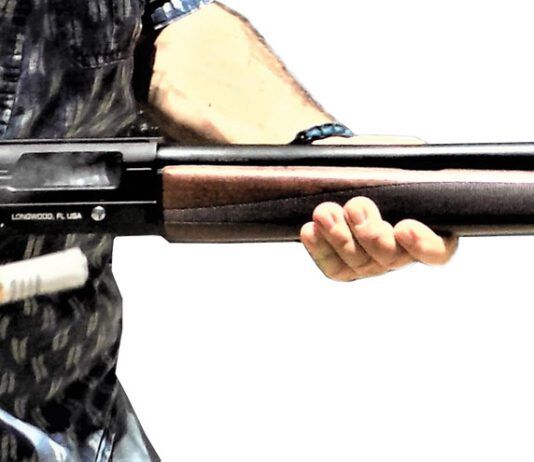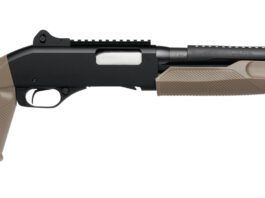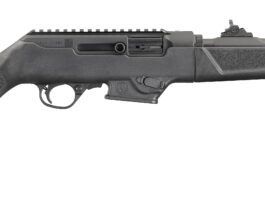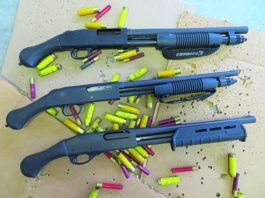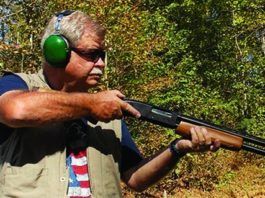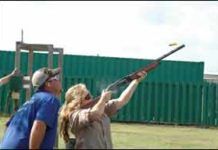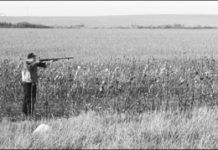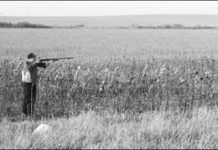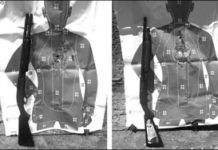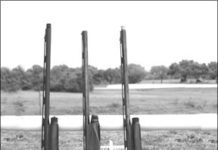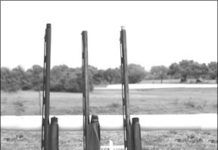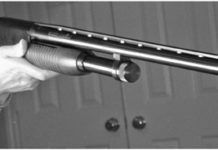Youth Semi-Auto 20 Gauges: CZs Model 720 Is a Best Buy
New shooters, especially young ones, usually begin training with a rimfire pistol or rifle because recoil is minimal. This makes it easier for the shooter to concentrate on fundamentals such as sight alignment and trigger control. Introducing a young beginner to shotgun shooting with a bore smaller than 12 gauge is a good idea for much the same reason. In this test we will evaluate three 20-gauge semi-automatic shotguns with reduced-length stocks. A shorter stock makes it easier for the younger or smaller shooter to point the shotgun and achieve a solid mount. Semi-automatic operation relies upon energy from the ammunition to cycle the bolt, so, in effect, each gun offered a built-in mechanism to reduce recoil to some degree or another. Our test shotguns were the $1299 Benelli Montefeltro Combo, Browning's $1179 Silver Hunter Micro Midas, and the $499 CZ 720 Reduced Length shotgun.
Our first step was to pattern each shotgun. This meant firing at a stationary paper target to determine the size, shape, and density of shot impact each gun would deliver at a given distance. For tips on patterning we visited the shop of Larry Feland located in Cypress, Texas (FelandGunsmith.com). Feland began his career in 1981 and soon found himself bending stocks and making leather pads for none other than Cyril Adams, one of the world's renowned double-gun experts and author of Lock Stock and Barrel: Making an English Shotgun and Shooting With Consistency. An expert in the field of shotgun fit, Feland specializes in aligning the shotgun with the eye of the individual to deliver shot where the shooter is looking.
The first question we asked Feland was if the procedure for patterning a semi-automatic was any different than patterning over/under or side-by-side shotguns. We also asked if 20-gauge shotguns should be patterned differently than 12-gauge models. The answer was no to both questions. But Feland did advise that the shotgun should be benched and shot like a rifle. This would help evaluate tendencies of elevation or alignment to the right or left by reducing the effects of individual shooter fit.
All three of our guns arrived with removable choke tubes. The choke tube acts like a funnel to regulate the final diameter of the bore and the manner in which shot is metered into the atmosphere. Some shooters feel that patterning with a choke that is more open will reveal more about the bore. But Feland pointed out that using a tighter choke would actually be more definitive. Not all of our test guns arrived with a full set of chokes, so we decided to pattern using the most commonly chosen constrictions, which are Improved Cylinder (IC) and Modified (MOD). Feland advised a pattern distance of 20 yards for testing with the IC choke and a distance of 35 yards to test with Modified chokes. Our pattern procedure was to mount each gun in a rifle rest and shoot one shot per target per choice of ammunition. First, we shot an IC choke at 20 yards, then installed the Mod choke and fired on the 35-yard board.
Each shotgun was capable of chambering 3-inch ammunition. But since were trying to avoid unnecessary recoil, we chose 2-inch cartridges from Remington and Winchester. The Remington Premier STS Target Loads and Winchester's AA Target Loads each launched a 7/8-ounce payload of No. 9 shot over a powder charge of 2 dram equivalent. Our choice of Winchester Super Target threw No. 8s.
Our next step was to put each shotgun into the hands of a young beginner shooter under the watchful eye of an instructor. Our junior shooter was a 15-year-old young lady whose previous experience was limited to informal clay shooting with her father's Browning A5 12-gauge shotgun, probably less than 75 rounds in total. Our choice of instructor came by way of recommendation from World Side by Side Champion Ed Arrighi. Brian Ash, the son of sporting clays gurus Gil and Vicki Ash, literally grew up in the sport. His input regarding course design has been sought repeatedly by the National Sporting Clays Association for the national championships held annually at the National Shooting Complex in San Antonio, Texas. Ash (email: Bash390@aol.com) teaches at American Shooting Centers located in George Bush Park in Houston, Texas (AMShootCenters.com). Lessons for our beginning shooter utilized several shooting stations along the Blue Sporting Clays trail designated for beginning and intermediate shooters. She shot the stations a minimum of three times to cover all three shotguns. Because the Benelli Combo also shipped with a full-length stock, we enlisted an adult beginner to challenge clay targets on the skeet field. We chose the Winchester Super Target ammunition for the bulk of our field shooting with the supplied Modified chokes installed. Here is what we learned.
20-Gauge Pump Shootout: BPS Slide-Action Has What We Want
20-Gauge Pump Shootout: BPS Slide-Action Has What We Want
Choosing a 20-Gauge Pump: Remington Edges Mossberg
20-Gauge Semis: Beretta Ekes Out Win in Competition Clash
There are two sides to the competitive shooting coin—one side is the challenge of being the best you can be and the other side is just being able to have a little fun. Picking the right shooting tool to handle both sides of this coin has become a lot easier with the availability of a good number of quality, fine-handling 20-gauge semiautomatics. These small gauge shotguns provide the shooter with a lighter, quicker target-busting tool that also carries the freight in the field during bird-hunting sessions.
For our field test, we selected three 20-gauge semiautomatics for a clay-crunching challenge that pitted a trio of Italian-made shotguns in a head to head to head battle. The three shotguns we collected from Dury's Gun Shop in San Antonio were the Benelli Super Sport, $1,700; the Benelli Cordoba, $1,500; and the Beretta AL 391 Urika, $1,350. All prices reflect Dury's asking price at the time of our test.
As noted, all of the shotguns are made in Italy and all of them have very similar dimensions, although both the Benelli shotguns featured synthetic stocks and forearms while the Beretta offered the more traditional satin-finished walnut stock and forearm. With all sporting 28-inch ported barrels to help reduce recoil and with little difference in weight and overall length, our test team placed increased emphasis on function and handling ability—and also factoring in the price tags as another ledger entry.
Our test ammunition for the trio included Estate Super Sport Competition Target 2.75-inch, 2.5-dram-equivalent shells in No. 7 1/2 shot (muzzle velocity 1200 fps); and Winchester AA Super Sport Sporting Clays 2.75-inch, 2.5-dram-equivalent shells in No. 7 1/2 shot (muzzle velocity 1300 fps). We patterned each of the shotguns with both types of ammunition, using Improved Cylinder chokes when firing at paper set up 25 yards downrange.
The Beretta produced the best pattern, a 50-50 spread with half of the hits above the center and half below. Patterns were 60-40 (more hits below the center than above the center) with both of the Benelli shotguns. The Super Sport was also patterned slightly to the left. While all the patterns were acceptable for both clays and birds, the Beretta scored the first victory in our testing with its paper punching performance.
Here are the rest of our test results:
20-Gauge Semis: Beretta Ekes Out Win in Competition Clash
There are two sides to the competitive shooting coin—one side is the challenge of being the best you can be and the other side is just being able to have a little fun. Picking the right shooting tool to handle both sides of this coin has become a lot easier with the availability of a good number of quality, fine-handling 20-gauge semiautomatics. These small gauge shotguns provide the shooter with a lighter, quicker target-busting tool that also carries the freight in the field during bird-hunting sessions.
For our field test, we selected three 20-gauge semiautomatics for a clay-crunching challenge that pitted a trio of Italian-made shotguns in a head to head to head battle. The three shotguns we collected from Dury's Gun Shop in San Antonio were the Benelli Super Sport, $1,700; the Benelli Cordoba, $1,500; and the Beretta AL 391 Urika, $1,350. All prices reflect Dury's asking price at the time of our test.
As noted, all of the shotguns are made in Italy and all of them have very similar dimensions, although both the Benelli shotguns featured synthetic stocks and forearms while the Beretta offered the more traditional satin-finished walnut stock and forearm. With all sporting 28-inch ported barrels to help reduce recoil and with little difference in weight and overall length, our test team placed increased emphasis on function and handling ability—and also factoring in the price tags as another ledger entry.
Our test ammunition for the trio included Estate Super Sport Competition Target 2.75-inch, 2.5-dram-equivalent shells in No. 7 1/2 shot (muzzle velocity 1200 fps); and Winchester AA Super Sport Sporting Clays 2.75-inch, 2.5-dram-equivalent shells in No. 7 1/2 shot (muzzle velocity 1300 fps). We patterned each of the shotguns with both types of ammunition, using Improved Cylinder chokes when firing at paper set up 25 yards downrange.
The Beretta produced the best pattern, a 50-50 spread with half of the hits above the center and half below. Patterns were 60-40 (more hits below the center than above the center) with both of the Benelli shotguns. The Super Sport was also patterned slightly to the left. While all the patterns were acceptable for both clays and birds, the Beretta scored the first victory in our testing with its paper punching performance.
Here are the rest of our test results:
20-Gauge Youth Shotguns: Are They Effective For Self Defense?
We wanted to know if these smaller, lighter guns were suitable for home protection. Tested: Winchester's Ranger Compact, Remington's 870 Youth Express, and the Mossberg Bantam.
Remington 870 Express Tops Other 20 Gauge Combo Shotguns
The 12-gauge shotgun is overwhelmingly popular with American shooters, but the 20-gauge shotgun is also an effective hunting tool when it is used properly. Although we have tested several standard shotguns in this gauge, this is our first evaluation involving 20-gauge slugs.
Ammunition of this kind is available with a rifled or a sabot slug that weighs either 5/8-ounce (275 grains) or 3/4-ounce (328 grains). The lighter slugs are loaded to a muzzle velocity of around 1,450 feet per second for a muzzle energy of 1,285 foot pounds. The heavier slugs are good for around 1,600 feet per second and 1,866 foot pounds. In contrast, a 12-gauge 1-ounce slug with a velocity of 1,600 feet per second...
Magnum Pump-Gun Matchup: Benelli, Mossberg Go At It
Wanted: A simple, all-purpose pump shotgun for hunting upland game and waterfowl. Must be low-maintenance, tough, attractive, handy, inexpensive, and reliable. Serious inquiries only, please

























